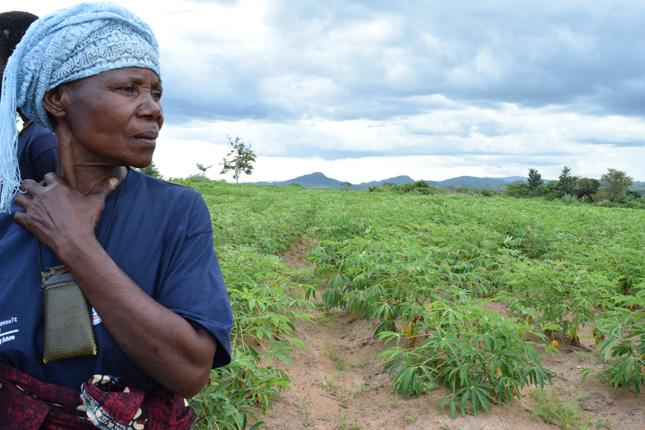-
Reaching for Resilience in East Africa
July 26, 2018 By Daniel Lohmann
“Resilience isn’t an outcome, it is a process—and capacity-building is crucial,” said Chelsea Keyser, Deputy Chief of Party for USAID’s PREPARED program, during a recent event at the Wilson Center marking the end of the five-year project. PREPARED (Planning for Resilience in East Africa Through Policy, Adaptation, Research, and Economic Development) developed 14 different tools to help communities adapt to the impacts of the changing environment in the East African region, including unreliable rainfall and rising temperatures.
The program, in which USAID partnered with the East African Community (which comprises Burundi, Kenya, Rwanda, Uganda, and Tanzania) and other key partners, worked at the regional level to build “the capacity to cope with uncertainty rather than react to a specific climate event,” said Scott McCormick of Tetra Tech, which led the consortium. For example, the PREPARED program trained more than 50 regional stakeholders in valuing ecosystem services. One stakeholder, the Ugandan Wetlands Department, secured a commitment from the Ugandan Ministry of Environment and Water to more than triple the size of the protected wetlands in the Nabugabo region based on their determination that this would increase the economic value of the wetland’s ecosystem services by 90 percent, reported Keyser. In another notable example of the program’s work, PREPARED worked with Uganda’s National Water and Sewerage Corporation to reduce water losses and increase efficiency, making it possible to reach 12,000 new customers.
Mapping Vulnerability
Climate change poses a significant threat to East Africans, whose lives depend on natural resources, particularly reliable sources of water for drinking and for farming. “Since the 1980s, there has been a significant increase in…temperature over the Lake Victoria Basin,” said McCormick, which will lead to “larger amounts of evapotranspiration and…more erratic rainfall patterns across the region. This will have an impact on East African water supplies.”
PREPARED began by identifying key regions of need and gathering the empirical data necessary to understand, measure, and monitor the most relevant issues. Columbia University’s CIESIN utilized monitoring tools such as GeoCLIM (which was developed to support PREPARED) to track place- and context-specific climate data essential to promoting resilience. CIESEN then created vulnerability maps that combined spatial data with weather station data around the Lake Victoria Basin region. Resilience is “hard to measure and … hard to incorporate into management,” said Marc Levy, Deputy Director of CIESIN. But measuring and mapping vulnerability creates “a built-in commitment to keep the needs of the most disadvantaged right in front of you.”
Partnering With People
The program team held workshops with 90 different local stakeholder communities across the region to convert what they learned from the maps and data into implementable adaptation plans. The plans were a simple result of “basic, hard, sustained work. Enabling the right people to use [data] output is simply a matter of training and awareness building,” said Levy.
By meeting with local organizations, communities, and individuals to identify their key concerns, and then by comparing and contrasting local knowledge with the empirical data, the PREPARED team was able to assess their needs and customize the solutions to meet them. These assessments led to the development of specific tools designed to meet local goals.
For example, an analysis of human-wildlife conflict and the impact on biodiversity led to the development of a mobile app named Wildlife Information Landscape Database (WILD) designed to aid park rangers in tracking and preventing elephant poaching. Another effort utilized a bottom-up approach to develop management plans for Tanzania’s Mara Wetlands. By starting with small villages and then working all the way up to the ministerial level, the team garnered crucial buy-in for the plan while ensuring that it comprehensively addressed the issues across the region. The effort culminated in Conservation Investment Plan for the Mara Wetlands, released by Tanzania’s Ministry of Natural Resources and Tourism in December 2017.
Sustaining Regional Resilience
After the PREPARED program ends in September, will these solutions last? The effort the program spent building trust with the populations they served should help projects endure. PREPARED identified local “champions” to continue the initiatives, who now comprise a “mature dynamic knowledge ecosystem that attracts new users and improves over time,” said Levy. The communities’ inclusion and participation throughout the process was designed to ensure the project’s impact lasts beyond its expiration.
The project’s regional scope should also help it be sustainable. Bringing together diverse groups of scientists and participants from different East African nations fostered the development of expert networks, south-south cooperation, and institutional capacity building.
“People cross boundaries; wildlife crosses boundaries, as does pollution,” said Mary Rowan, Senior Wildlife Advisor for USAID’s Bureau for Economic Growth, Education and Environment, Office of Forestry and Biodiversity, so there “has to be a regional approach” that allows countries to work together to address the most critical issues they share. This requires multisectoral coordination of the “money of different flavors” that USAID receives from Congress, added Rowan. “To really address resilience, we need to pool those resources together.”
Envisioning the Future
“Without the support of regional programs and collaboration with regional institutions, we miss a lot of opportunities to work on issues like resilience,” said Blaine. Resilient solutions to environmental changes “don’t just return [stakeholders] to where they were in the past, but actually help reduce vulnerability and facilitate growth,” she said. The tools developed by PREPARED are “a way of envisioning the future, and figuring out how to get there.”
Event Resources:
Sources: Climate Hazards Group, Climate Links, Nature Uganda, U.S. Agency for International Development
Photo courtesy of Tetra Tech. All rights reserved.
 A Publication of the Stimson Center.
A Publication of the Stimson Center.




